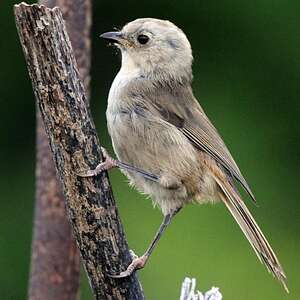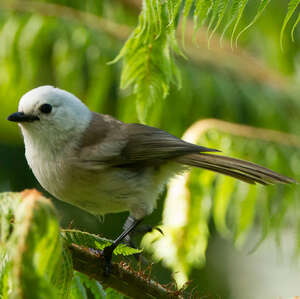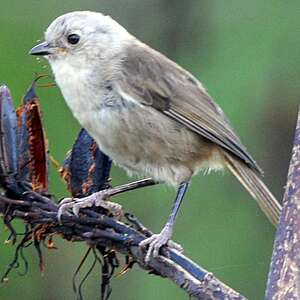Whitehead
Mohoua albicilla - Mohoua à tête blanche
Identification
Small bird with a compact body, short tail, short beak and long legs. Although some species such as the House Sparrow and grey-backed zosterops are similar in size, the distinctive white head and belly colouring easily distinguish the Whitehead from other small passerines. Mainly confined to the canopy foliage. Whitish head, brownish-yellow belly and tail.
Adult male: white head, nape, neck, chest, mid-belly and undertail, slightly tinged with brown, particularly on the body. Pale brown flanks, upper wing coverts paler. Dark brown remiges; outermost primaries bordered with grey and inner part whitish-yellow. Iris, beak, tarses and legs black, with the underside of the fingers paler and the claws brown.
Adult female: similar to adult male, but slightly smaller, nape and crown tinged with brown.
Immature: similar to adult female but with grey belly.
Subspecific information monotypic species
Foreign names
- Mohoua à tête blanche,
- Mohoua cabeciblanca,
- moúa-de-cabeça-branca,
- Weißköpfchen,
- fehérfejű maoriposzáta,
- Witkopmohoua,
- Testabianca,
- vithuvad mohua,
- Hvithodemohua,
- proroček bielohlavý,
- pištec bělohlavý,
- Hvidhovedet Mohoua,
- moua capblanca,
- maorysek białogłowy,
- Белоголовая мохуа,
- シロモフアムシクイ,
- 白头刺莺,
- vithuvad mohua,
- 白頭刺鶯,
Voice song and call
Habitat
Behaviour character trait
During the breeding season, they form very noisy groups and are sedentary. These groups break up in the canopy or disperse to increase their food areas during the non-breeding season. Whitehead Mohouas are gregarious, they live in small groups of up to eight birds and are often heard before being seen. It is the only host parasitized on the North Island by the New Zealand Cuckoo.
Dietfeeding habits
It feeds on insects, mainly caterpillars, beetles, spiders caught in the vegetation from the ground to the canopy although they catch flying insects and sometimes grain fruits or other vegetable matters. They move quickly through the canopy while searching for food and are often observed with their heads down. Whitehead mostly hunts for caterpillars, beetles, spiders and other arthropods, after which they may supplement with fruit or other vegetable matter.
Reproduction nesting
Once a year from September to January, the Whitehead builds its nest - a neatly crafted, tightly woven cup lined with soft materials such as natural fibers or moss.
It's usually set in a tree fork, hidden in the dense vegetation of the treetop canopy. Annual breeders, they normally lay two to four eggs, spaced 24 hours apart. Egg colors range from white to deep pink, but most are white, delicately spotted or marbled light yellow to reddish brown, with denser markings towards the larger end. Only the female incubates. Both sexes feed the chicks. They are usually discreet around the nest. Incubation time lasts from 17 to 19 days, and young fledge at 16 to 19 days, but remain dependent for up to 9 months. Complete molt takes place after breeding season, between January and April.Geographic range
Whitehead is found and exclusively breeds on North Island in New Zealand. Its continental range lies south of a line connecting the Pirongia Forest, Hamilton and Te Aroha. It is locally common, though patchily distributed south of this line, and population to the north is limited to a few offshore islands plus a fenced reintroduction site. They are naturally common on the islands of Kapiti and Little Barrier, and have been successfully introduced to the islands of Tiritiri Matangi, Motuora and Tawharanui Regional Park in the Auckland region. They can be among the most abundant of forest birds present on these sites where mammalian predators are effectively controlled or excluded.
Threats - protection
IUCN conservation status
concern
in the Wild
threatened
evaluated
In the past, the number of Whitehead Mohouas has greatly decreased due to deforestation and predation by introduced mammals (notably the rat and stoat). These birds are reluctant to cross open areas and are sensitive to habitat fragmentation, resulting in a non-reconstitution of populations. It disappeared in the late 1800s from the north of the North Island. They survived on Little Barrier and Kapiti Island, with these two populations being used as sources for repopulation.
Sources of information
- IOC World Bird List (v15.1), Gill, F and D Donsker (Eds). 2025-12-07.
- Wikipedia (English version),
Other sources of interest
 Specification sheet created on
31/07/2023 by Yann Cambon
Specification sheet created on
31/07/2023 by Yann CambonTranslation by AI Oiseaux.net
© 1996-2026 Oiseaux.net
- Accipitriformes
- Aegotheliformes
- Anseriformes
- Apodiformes
- Apterygiformes
- Bucerotiformes
- Caprimulgiformes
- Cariamiformes
- Casuariiformes
- Charadriiformes
- Ciconiiformes
- Coliiformes
- Columbiformes
- Coraciiformes
- Cuculiformes
- Eurypygiformes
- Falconiformes
- Galliformes
- Gaviiformes
- Gruiformes
- Leptosomiformes
- Mesitornithiformes
- Musophagiformes
- Nyctibiiformes
- Opisthocomiformes
- Otidiformes
- Passeriformes
- Pelecaniformes
- Phaethontiformes
- Phoenicopteriformes
- Piciformes
- Podargiformes
- Podicipediformes
- Procellariiformes
- Psittaciformes
- Pterocliformes
- Rheiformes
- Sphenisciformes
- Steatornithiformes
- Strigiformes
- Struthioniformes
- Suliformes
- Tinamiformes
- Trogoniformes
























